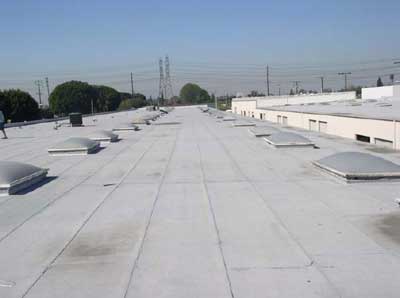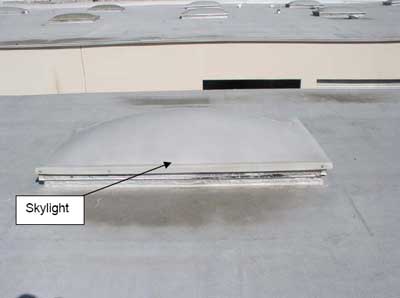A Hispanic Maintenance Worker Dies after Falling Through a Skylight
California Case Report: 07CA007
Summary
A 39-year-old Hispanic maintenance worker died from injuries received after a fall through a skylight. The victim was using a broom to clean the debris off the skylight. As the victim was applying pressure to the broom, the broom handle broke. The victim lost his balance and fell through the skylight cover and opening approximately 17 feet to the floor below. The employer of the victim had no written employee safety or training programs. The CA/FACE investigator determined that, in order to prevent future occurrences, employers should:
- Develop and implement safe procedures for cleaning skylights.
- Establish and maintain an Injury and Illness Prevention Program (IIPP).
Introduction
On June 15, 2007, at approximately 10:00 a.m., a 39-year-old Hispanic maintenance worker died from injuries received after he fell through a skylight. The CA/FACE investigator learned of this incident on June 28, 2007, from the Cal/OSHA Bureau of Investigations. Contact with the victim’s employer was made on September 24, 2007. On October 2, 2007, the CA/FACE investigator traveled to the company that employed the victim, interviewed the supervisor of the victim, and inspected the building where the incident occurred. The co-worker of the victim was interviewed, and photographs were taken at a later date.
The employer of the victim was an industrial property management company. The company had been in business for over 50 years and had five employees. The victim had worked for the company for six months as a maintenance worker or janitor. He had never cleaned a skylight in the past. The victim was born in Mexico and had been in the United States for 24 years. He had a 10th grade education and could speak, read, and write English and Spanish. Although the victim spoke in Spanish when communicating with his co-worker, all communication between him and the supervisor was done in English.
The company did not have an Injury and Illness Prevention Program (IIPP) and did not provide specific safety training for employees, or hold safety meetings. The employer provided on-the-job safety instructions to the employees when needed and also provided protective safety gear when required.
Investigation
The site of the incident was an industrial building that housed numerous businesses and organizations. On the day of the incident, one of the tenants requested that the property management company clean the skylight on the roof of the building. The supervisor instructed the victim and co-worker to clean the skylight, but did not provide task-specific instructions.
The two maintenance workers secured an extension ladder to the outside of the building to gain access to the roof. The co-worker held the ladder while the victim climbed to the roof and located the skylight that was to be cleaned. The skylight was four feet wide and eight feet long, and had a fiberglass cover. Using a push broom, the victim started sweeping the debris off the skylight. As he applied pressure to the broom handle to sweep off dried bird droppings, the broom handle broke. The victim lost his balance and fell through the skylight cover and opening. He hit a sprinkler pipe and then fell 17 feet to the floor below. The co-worker notified the maintenance supervisor, and then went to the aid of the victim. The co-worker transported the victim by private vehicle to the hospital, where he died from his injuries eight days later.
Cause of Death
The cause of death, according to the death certificate, was traumatic injury to the liver and blunt force trauma.
Recommendations/Discussion
Recommendation #1: Develop and implement safety procedures for cleaning skylights.
Discussion: In this incident, the employer did not recognize the fall hazard for employees cleaning a skylight. Skylight cleaning safety procedures should include a site-specific safety plan (hazard analysis) that would identify employer expectations, safe work practices, and engineering safety devices and/or personal protective equipment required for the job. If a skylight or its cover is not designed to withstand at least 400 pounds/square foot, or twice the weight of the employee and his work gear, the employee must be protected from falling through the skylight. In this case, there should have been a screen, guardrails, or personal fall protection system in place. Job sites should be evaluated by a competent person to identify safety equipment and work practices that will be utilized to accomplish the work. Any safety issues or concerns, or potential hazards, should be identified before beginning work and become part of the site work plan. In this particular case, the use of any one of the devices or methods listed above would have prevented this incident.
Recommendation #2: Establish and maintain an Injury and Illness Prevention Program (IIPP).
Discussion: A documented safety program with a written IIPP is an effective method of identifying hazards and ensuring all employees receive the necessary safety information needed to do their jobs. An effective IIPP should include:
- The name of a person or persons with authority and responsibility for implementing the IIPP.
- A system for ensuring that employees comply with safe and healthy work practices.
- A system for communicating with employees in a form readily understandable by all affected employees on matters relating to occupational safety and health, including provisions designed to encourage employees to inform the employer of hazards at the worksite without fear of reprisal.
- Procedures for identifying and evaluating workplace hazards including scheduled periodic inspections to identify unsafe conditions and work practices.
- Procedures to investigate occupational injury or illness.
- Methods and/or procedures for correcting unsafe or unhealthy conditions, work practices, and work procedures in a timely manner based on the severity of the hazard.
- Training and instruction in assigned tasks to ensure all employees receive the same information and that their achievement of skills is verified before proceeding with the assigned task.
- Training in incident response; including first aid, triage, communication procedures between on-site responders/supervisors/911, and procedures for transport of the injured worker.
In this incident, an IIPP may have identified the fall hazard and procedures may have been implemented to prevent the risk of serious injury or death.
Reference
- California Code of Regulations, Subchapter 7. General Industry Safety Orders, Group 1. General Physical Conditions and Structures Article 2. Standard Specifications. §3212. Floor Openings, Floor Holes and Roofs
- Oregon Face Report https://www.cdc.gov/niosh/face/stateface/or/03or001.html
- NIOSH Alert: Preventing Falls of Workers Through Skylights and roof and floor openings. https://www.cdc.gov/niosh/docs/2004-156/#background
- Fall-Arrest.com siteexternal icon http://www.fall-arrest.com/fall-arrest-systems/rooftop-fall-protection/rooftop-skylight.asp (Link updated 8/5/2009)
Exhibits

|
|
Exhibit 1. The roof of the building where the incident occurred. |
 |
|
Exhibit 2. The skylight involved in the incident. |
California Fatality Assessment and Control Evaluation (FACE) Project
The California Department of Public Health, in cooperation with the Public Health Institute and the National Institute for Occupational Safety and Health (NIOSH), conducts investigations of work-related fatalities. The goal of the CA/FACE program is to prevent fatal work injuries. CA/FACE aims to achieve this goal by studying the work environment, the worker, the task the worker was performing, the tools the worker was using, the energy exchange resulting in fatal injury, and the role of management in controlling how these factors interact. NIOSH-funded, State-based FACE programs include: California, Iowa, Kentucky, Massachusetts, Michigan, New Jersey, New York, Oregon, and Washington.
To contact California State FACE program personnel regarding State-based FACE reports, please use information listed on the Contact Sheet on the NIOSH FACE web site. Please contact In-house FACE program personnel regarding In-house FACE reports and to gain assistance when State-FACE program personnel cannot be reached.
